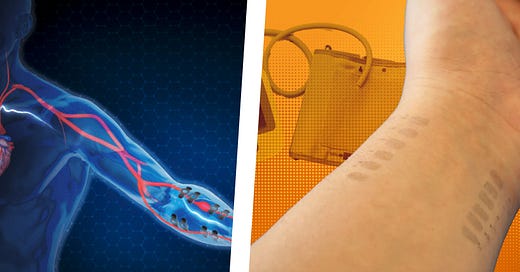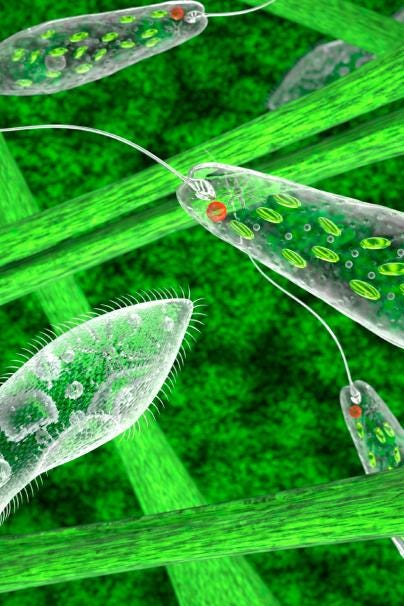#33 Blood Pressure E-Tattoos, Wild Tomatoes Helping Out and Ocean Cyanobacteria...
Wild tomato genomes benefiting their domesticated cousins, Blood Pressure E-Tattoo enabling mobile monitoring and cyanobacteria regulating zinc uptake...
🍅Wild Tomatoes Helping Out
Wild tomato genome benefiting domesticated tomatoes…

Solanum lycopersicoides are a wild relative of the domestic tomato and a valuable source of natural variation in tomato breeding. A team of researchers have assembled a reference genome and in doing so developed a web based tool that will allow plant researchers and breeders to improve the crop.
The species holds a gene that can make plants resistant to a particular strain of bacterial speck disease. The research team led by the Boyce Thompson Institute Researchers aimed to introduce the gene into the cultivated tomatoes to protect them from the pathogen. Through sequencing the plant’s genome they aimed to facilitate the discovery of more genes that could improve tomatoes.
Wild relatives of crops are highly valuable to plant researchers and breeders due to the fact the the domestication of crops narrows the gene pool. Wild relatives of domesticated plants can often retain genes that could be useful, including those resistant to drought and disease.
The study found several candidate genes associated with compounds (phenolics and carotenoids) involved in colour, flavour and nutrition as well as other genes associated with gene resistance. As well as the identification of these genes, the team wanted to make the information as widely accessible and useful to the scientific community as possible.
“These kinds of data are added to the National Center for Biotechnology Information repository as a general requirement, and that’s important, but not everyone is a bioinformaticist or has access to bioinformatics resources to analyse the data,” said Adrian Powell, first author on the paper. He added “To increase access and ease of exploring the genome, we developed web-based tools and components that researchers beyond our project team could use and add to”.
New technological tools combined with the new reference genome will have a number of applications. Researchers can analyse hybrids of the wild tomato more readily than they could before.
“For example, the reference genome could facilitate genome-wide association studies (GWAS) on multiple S. lycopersicoides accessions, to assess genetic diversity of the species and identify candidate genes for the traits breeders” said Powell.
🪡Bio E-Tattoo?
Blood pressure E-Tattoo promises mobile monitoring…
Blood pressure is defined as the force of circulating blood on the walls of the arteries. It is one of the most important heart health indicators yet is one of the hardest indicators to measure outside a clinical setting.
Researchers at University of Texas, Austin have developed an electronic tattoo that can be worn comfortably on the wrist for hours, replacing the cuff based devices that constrict around the arm. This new technology means that blood pressure measurements can be read for hours at an accuracy level exceeding all other options currently on the market.
“Blood pressure is the most important vital sign you can measure, but the methods to do it outside of the clinic passively, without a cuff, are very limited,” said Deji Akinwande, a professor in the Department of Electrical and Computer Engineering at UT Austin and one of the co-leaders of the project.
The team went on to say that taking infrequent blood pressure measurements has many limitations and that it does not provide insight into exactly how the body is functioning. The continuous monitoring that is possible through the e-tattoo allows for measurements to be taken in an array of situations including moments of high stress, sleeping, exercising and more…
Graphene is one of the strongest and thinnest materials in existence and a key ingredient in this new e-tattoo. E-tattoos make sense as a vehicle for mobile blood pressure monitoring for a few reasons. They reside in a sticky and stretchy material encasing the sensors that is comfortable to wear for long periods and does not slide around.
“The sensor for the tattoo is weightless and unobtrusive. You place it there. You don’t even see it, and it doesn’t move,”. “You need the sensor to stay in the same place because if you happen to move it around, the measurements are going to be different” said Roozbeh Jafari, a professor of biomedical engineering, computer science and electrical engineering at Texas A&M and the other co-leader of the project.
The device works by shooting an electrical current into the skin and then analysing the body’s response which is known as bioimpedance. There is a correlation between this bioimpedance and the change in blood pressure that has to do with blood volume changes. However this correlation is not always obvious and so the team had to create a machine learning model to analyse the connection to get accurate blood pressure readings.
In medicine, cuff-less blood pressure monitoring is the “holy grail,” Jafari said, but there isn’t a viable solution on the market yet. This new technology hopes to bridge the gap and to allow technology to ‘untether’ patients otherwise restricted by medical conditions.
“All this data can help create a digital twin to model the human body, to predict and show how it might react and respond to treatments over time,” Akinwande said.
🦠Ocean Cyanobacteria
Insights into how cyanobacteria regulate zinc uptake…

Cyanobacteria are a phylum of gram negative bacteria that obtain energy through photosynthesis. They are also known as blue-green algae and are often the cause of algal blooms in both freshwater and marine water ecosystems. Marine cyanobacteria are major contributors to the marine ecosystem as well as the global carbon cycle. Due to their photosynthetic nature, they only require sunlight, carbon and a few other essential elements.
However until now, there was relatively little known about whether and how cyanobacteria utilize or regulate zinc, an element often considered to be essential to life. An interdisciplinary team of researchers has identified the regulatory network that controls zinc accumulation in the open ocean.
This network allows Synechococcus (ocean cyanobacterium) to vary their internal zinc levels by over two orders of magnitude, and relies on a zinc uptake regulator protein (Zur) which can sense zinc and respond accordingly.
Unlike others, this sensor protein activates a bacterial metallothionein which together with highly efficient uptake systems is responsible for the extraordinary capacity of this organism to accumulate zinc.
“Our findings indicate that zinc is an essential element for marine cyanobacteria. Their ability to store zinc may facilitate enhanced phosphorus scavenging, a macronutrient that is extremely scarce in many regions of the world’s oceans. Zinc may also be required for efficient carbon fixation.” said Claudia Blindauer from Warwick’s Department of Chemistry.
The team went on to say how these features are not yet reported for any other bacterium but are key to the success of this cyanobacterium species globally.
Professor Dave Scanlan of Warwick’s School of Life Sciences added that “The oceans are the somewhat overlooked ‘lungs’ of our planet – every other breath we take is oxygen evolved from marine systems whilst around a half of the carbon dioxide fixed into biomass on Earth occurs in ocean waters. Marine cyanobacteria are key players in Earth’s ‘lungs’ and this manuscript reveals a novel aspect of their biology, namely the ability to exquisitely regulate zinc homeostasis, a feature that has undoubtedly contributed to their ability to fulfil these key planetary functions.”
Weekly Topics
🏞️ Environmental
Impact of plastic on small mammals
Mining’s effect on fish warrants better policies
The environmental cost of cheating…
🦭Marine
Climate change in ocean water may impact mangrove dispersal
Sea sponges dying by the millions…
Bacterium the size of an eyelash
🐼 Conservation
Identifying bird species by sound…
Chimpanzees digging wells for cleaner water
🦠 Disease and Illness
Can our mitochondria help beat long COVID
New designer cells could advance treatments for illness and disease
Tissue model reveals key players in liver regeneration…
😷 COVID
Omicron variant leads to less severe disease in Mice
Recombinant SARS-CoV-2 harbouring double reporters for COVID
Rapid test can identify variant in hours…
🧪 Biochemistry
Biochemists use enzymes to change how brain cells communicate with each other?
Discover new family of sensing genes in enteric bacteria using AI
New machine learning method may improve gene identification
🔬 Evolution
Study begins to unravel the mysterious evolution of fatherless male insects…
Could consciousness have evolved?
Legendary bacterial evolution experiment enters new era
🧬 Genetics
Most silent genetic mutations are harmful not neutral…
How to find marker genes in cell clusters…
📷 Weekly Camera Roll
Click on the text below to keep reading…
Reference List
Content may be adapted and edited for style and length.
🍅Wild Tomatoes Helping Out
Powell, A., Feder, A., Li, J., Schmidt, M., Courtney, L., Alseekh, S., Jobson, E., Vogel, A., Xu, Y., Lyon, D., Dumschott, K., McHale, M., Sulpice, R., Bao, K., Lal, R., Duhan, A., Hallab, A., Denton, A., Bolger, M., Fernie, A., Hind, S., Mueller, L., Martin, G., Fei, Z., Martin, C., Giovannoni, J., Strickler, S. and Usadel, B., 2022. A <i>Solanum lycopersicoides</i> reference genome facilitates insights into tomato specialized metabolism and immunity. The Plant Journal, 110(6), pp.1791-1810.
News Press Release: https://news.cornell.edu/stories/2022/06/wild-tomato-genome-will-benefit-domesticated-cousins
🪡Bio E-Tattoo?
Kireev, D., Sel, K., Ibrahim, B., Kumar, N., Akbari, A., Jafari, R. and Akinwande, D., 2022. Continuous cuffless monitoring of arterial blood pressure via graphene bioimpedance tattoos. Nature Nanotechnology,.
News Press Release: https://news.utexas.edu/2022/06/20/blood-pressure-e-tattoo-promises-continuous-mobile-monitoring/
🦠Ocean Cyanobacteria
Mikhaylina, A., Ksibe, A., Wilkinson, R., Smith, D., Marks, E., Coverdale, J., Fülöp, V., Scanlan, D. and Blindauer, C., 2022. A single sensor controls large variations in zinc quotas in a marine cyanobacterium. Nature Chemical Biology,.
News Press Release: https://warwick.ac.uk/newsandevents/pressreleases/new_insights_into_how_cyanobacteria_regulate_zinc_uptake_in_the_open_ocean1






